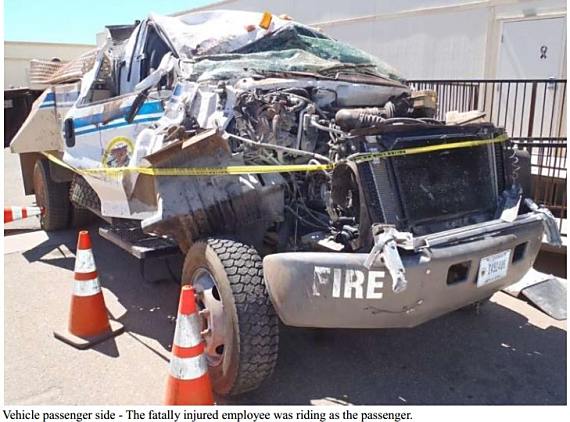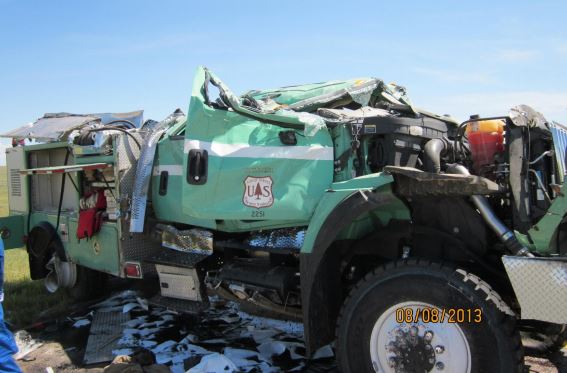
In 2009 we started to notice that rollovers of fire apparatus was far too common, and too often resulted in death or serious injuries. By July 17, 2015 we had reported on 17 rollovers of fire vehicles responding to or working on wildland fires that resulted in 44 injuries or fatalities to firefighters working on or responding to a wildland fire. That does not include non-rollover vehicle accidents, rollovers of heavy equipment (of which there were quite a few), or accidents that occurred in Australia and Canada. By that date we had had enough, and wrote an article that strongly advocated rollover protection be added to wildland fire engines, Fire vehicle rollovers — how serious a problem is it?

To date we have written 69 articles tagged “rollovers.”
In the article below published Nov. 24, 2021, the Bureau of Land Management notes that after another fatal rollover that killed two more Department of the Interior firefighters in 2016, they decided that rollover protection was needed. Apparently the rollover that killed a BIA firefighter and seriously injured another in 2012 (see photo above) was not enough to prompt them to take action. The agency deserves praise for beginning this program to enhance the safety of their firefighters.
By Carrie Bilbao, BLM Fire Public Affairs Specialist
The BLM National Fire Equipment program (NFEP) located at the National Interagency Fire Center (NIFC) in Boise, Idaho provides standardized wildland fire engines, crew carriers, helitack support vehicles, command vehicles, bulldozers, and other specialized wildland fire apparatus to four agencies in the U.S. Department of Interior.
Following a fatal traffic accident in July 2016 that tragically took the lives of two BLM firefighters when their wildland fire engine was involved in a single-vehicle rollover, the national fire equipment and fire and aviation contracting programs began extensive research on rollover protection systems (ROPS). When they started working with private industry, there were no manufacturers developing ROPS for heavy trucks. Initially, NFEP and BLM Fire contracting educated the manufacturers and private industry that there is a need to invest in a ROPS to protect our field firefighters. Then they started working with private industry and truck manufacturers to design and test ROPS.

The safety features of ROPS include seats with side impact airbags, seatbelt pre-tension system, and internal roll cage. The new seat system senses a rollover event and releases air from the seat and retracts the seatbelt to pull the occupants to the lowest seating position and secures them to the seat, all in fractions of a second. This increases the crush area above their heads and protects them from projecting forward. The airbag also deploys, which gives the occupants protection in the roll. The internal roll cage provides stability to the chassis to prevent it from collapsing, potentially crushing firefighters inside in the event of a rollover accident. A “superstructure” is also integrated into the fire body. It is designed to increase the cab crush angle, providing more survivable space for the occupants. The superstructure, new seats, and roll cage will provide the wildland fire community with the safest cab ever. The NFEP’s development and integration of this technology will benefit the entire wildland fire community.


“While firefighter safety is at the forefront of everything we do, it is inherently a dangerous job,” said Elden Alexander, the BLM National Fire Equipment program manager. “On a single fire dispatch, fire resources can respond 100 miles on the highway, traverse steep mountain roads, and then transition to using equipment off-road while suppressing fire. This new design adds an extra feature to keep firefighters safe. We are extremely proud of what we have accomplished and are already looking forward to the next phases of safety systems in the rest of our fire fleet. Simply said, we aren’t done yet.”
In 2021, the NFEP retrofitted 14 heavy engines with the newly developed ROPS. In the future, ROPS will be added to each contract and will be built by the manufacturer prior to being issued to the field. The outstanding work on ROPS will greatly improve the crashworthiness and survivability of our off-road wildland fire engines for all wildland fire engine personnel and will set a new industry standard. Integrating additional cab protection in all BLM Fire apparatus including crew carriers, water tenders, and dozer transports remains a priority for NFEP. The advancement in ROPS safety technology will benefit not only the U.S. Department of Interior fire programs, but well beyond them.
For the outstanding work done on research and development of this innovative safety feature, the NFEP and BLM FAD contracting recently received the DOI Safety and Health Award of Excellence. This award recognizes individuals or groups who have performed an outstanding service or have contributed unusual value to the occupational safety and health of employees, visitors, and volunteers.

It would be interesting to know how many rollovers are due to rough terrain and how many are due to going too fast and losing control, as is evident in one of the pictures. If the latter is the situation, roll cages will add to the unwarranted feeling of invincibility and we may see rollovers actually increase. Hopefully fatalities will still decrease.
That’s why I drive without me seatbelt on, ensures I drive safer…Imagine If helmets were required, pure chaos on the roads. Bahaha!
Having worked closely with the NFEP during my tenure with the BLM im glad to see this finally coming to fruition. Elden and the folks who work R&D are at the upper echelon and at the forefront of progress. One thing that I feel hasn’t been addressed here were the causes of the rollover accidents. The majority were due to driver error and fatigue. ROPS will only take you so far. There is still no excuse for lack of driver training/experience, receiving required rest/fit for duty, and/or pushing the limits of the equipment used to combat wild land fires. It scares me to see the attrition rate. I hope the drivers being placed in the seat recognize that they are not only responsible for the equipment, but are also responsible for the lives in the seats next to them.
I am glad that this has been addressed and crash and roll protection is being installed into vehicles. This was always one of my biggest concerns while fighting fires from engines for many years.